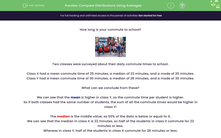How long is your commute to school?

Two classes were surveyed about their daily commute times to school.
Class X had a mean commute time of 25 minutes, a median of 22 minutes, and a mode of 20 minutes.
Class Y had a mean commute time of 30 minutes, a median of 28 minutes, and a mode of 30 minutes.
What can we conclude from these?
We can see that the mean is higher in class Y, so the commute time per student is higher.
So if both classes had the same number of students, the sum of all the commute times would be higher in class Y!
The median is the middle value, so 50% of the data is below or equal to it.
We can see that the median in class X is 22 minutes, so half of the students in class X commute for 22 minutes or less.
Whereas in class Y, half of the students in class X commute for 28 minutes or less.
Finally, the mode is the most frequent time.
We can see that the modes are 20 and 30 minutes in the two classes.
This might be because students are rounding up or down to tens as they are estimating their commute times rather than precisely measuring them.

Class Y has a higher mean, median, and mode compared to class X, indicating that, on average, students in class Y have longer commute times.
Class Y also has smaller differences between the mean, median, and mode.
This means that class Y has a smaller spread of commute times - which means more consistency in commute times compared to class X!
In other words, class Y's students have more similar commute times to each other than the students in class Y.
Ready to compare data distributions yourself?







